Indian folk paintings are a kaleidoscope of colours, symbols, and stories that reflect the country’s deep cultural roots. Among the myriad influences on this art form, mythology stands as a cornerstone, shaping not just the narratives but also the techniques, motifs, and purposes of these captivating creations. The intricate bond between mythology and Indian folk paintings highlights the enduring legacy of oral traditions, religious beliefs, and community practices in India’s artistic heritage.
The Intersection of Mythology and Folk Art
Indian mythology, with its vast pantheon of gods, goddesses, and mythical tales, has provided an abundant source of inspiration for folk artists. These mythological stories are often passed down through generations, not only as oral traditions but also as visual narratives etched in art. From the epics of the Mahabharata and Ramayana to the lyrical stories of Krishna Leela, these narratives have transcended time, becoming visual stories on walls, canvases, and paper. These paintings serve as more than just aesthetic expressions; they act as cultural conduits, preserving age-old traditions and connecting generations.
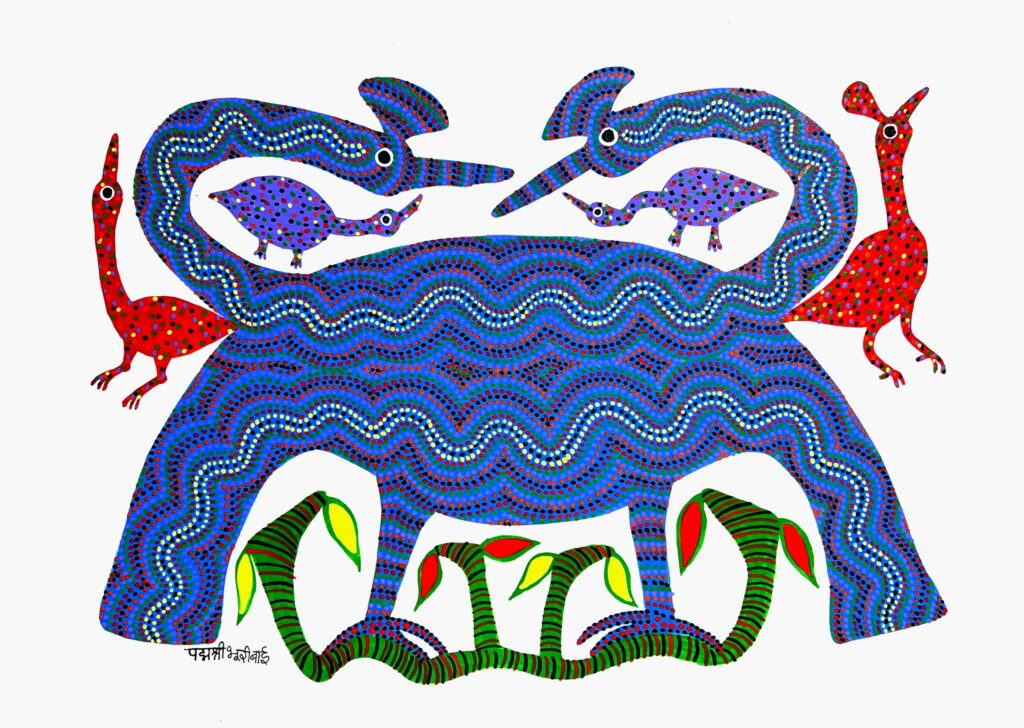
Mythology provides the scaffolding upon which artists build their creative expressions, making the art a feast for the eyes and a repository of cultural memory. These paintings bring the stories of gods, heroes, and cosmic events to life in vivid detail, ensuring their immortality.
Prominent Indian Folk Painting Styles and Their Mythological Themes
Madhubani Painting
Hailing from the Mithila region of Bihar, Madhubani painting is synonymous with vibrant colours, detailed patterns, and spiritual motifs. This art form has been practised predominantly by women, who traditionally used natural dyes and pigments to create intricate works on walls and floors. Mythology plays a significant role in this art form, with scenes from the Ramayana and Mahabharata frequently depicted. For instance:
- The wedding of Rama and Sita is a recurring theme, symbolizing divine love and duty. This moment, captured in minute detail, often includes elaborate designs that highlight the auspiciousness of the union.
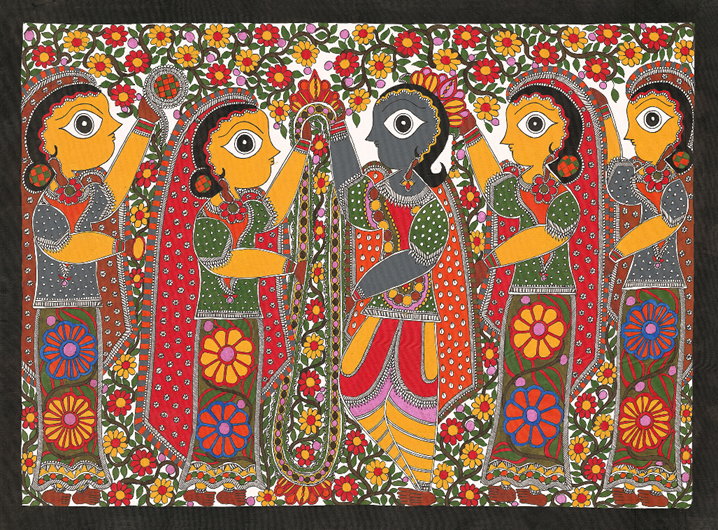
- Episodes featuring Krishna and Radha reflect themes of devotion, eternal love, and the joy of divine play. These scenes are often adorned with motifs like peacocks and lotus flowers, which carry their symbolic meanings.
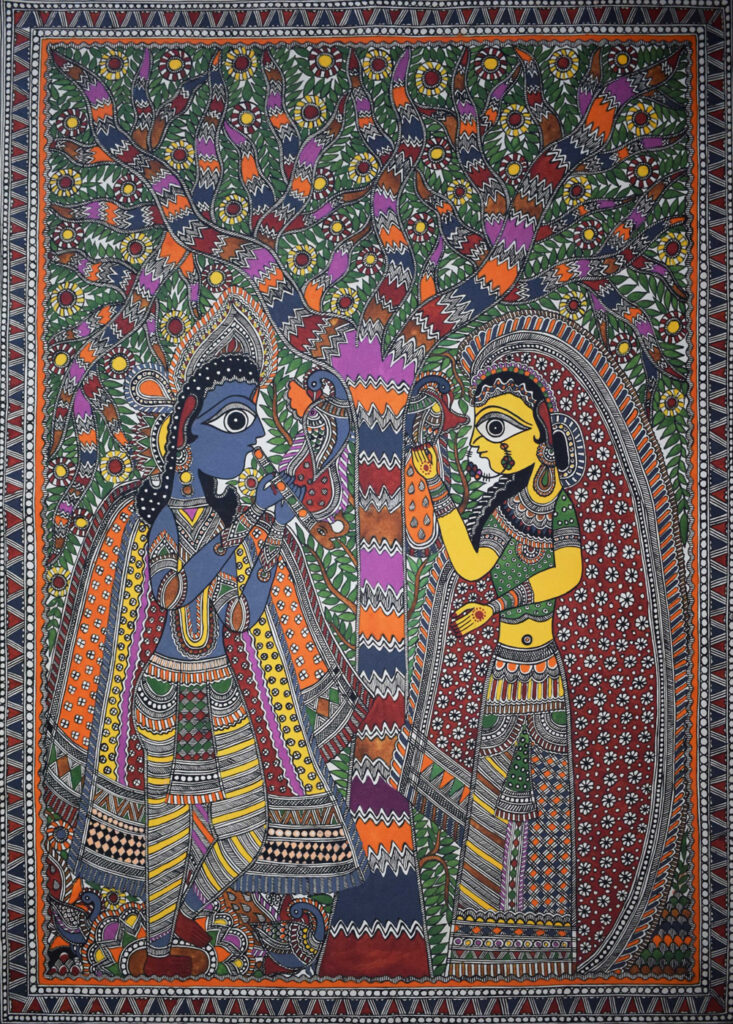
The use of natural dyes and symbolic elements, such as fish (representing prosperity), lotus (spiritual awakening), and bamboo (fertility), enriches the narrative. The symmetry and repetition in Madhubani patterns also reflect a deep spiritual connection to the universe, showcasing how mythology and cosmology intertwine in this art form.
Pattachitra
Originating from Odisha and West Bengal, Pattachitra translates to “picture on cloth.” This art form is deeply entwined with the worship of Lord Jagannath, an incarnation of Vishnu, at the Puri temple. The intricate craftsmanship of Pattachitra painters, known as Chitrakars, is a testimony to their devotion and skill.
Pattachitra artists often depict:
- The Dasavataras (ten incarnations of Vishnu) are each rendered with meticulous attention to detail and vibrant colours.
- Scenes from Krishna’s childhood, like him stealing butter or performing the Raslila, capture the playful and divine aspects of the deity.
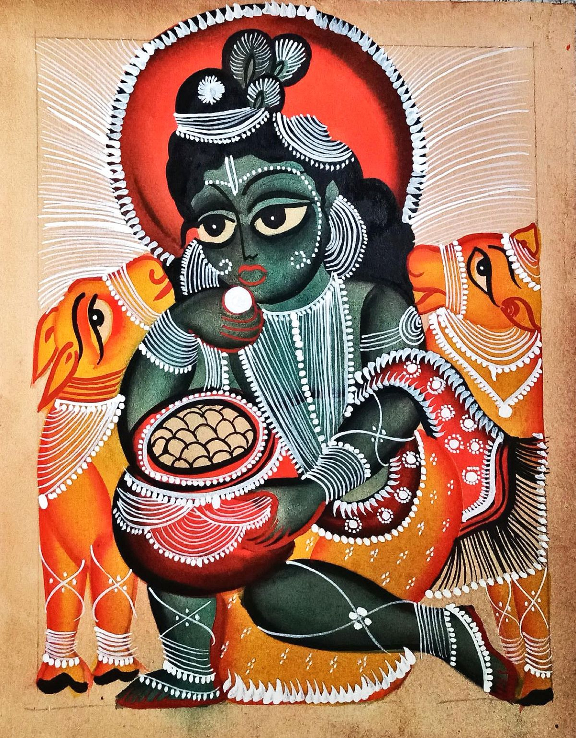
The detailed borders, bold primary colours, and mythological themes are hallmarks of this style. Like a scroll, the stories unfold across panels, inviting viewers to journey through the episodes. The precision and artistry involved in Pattachitra underscore its importance as a medium for preserving and celebrating mythology.
Warli Art
Though seemingly simplistic with its monochromatic palette and stick-figure depictions, Warli art from Maharashtra carries profound meaning. This tribal art form often draws inspiration from local myths and rituals. The Warli community’s close relationship with nature is evident in their art, which celebrates the cycles of life and the divine forces that govern them.
Key mythological elements in Warli art include:
- Depictions of Mother Earth or Pachamama, symbolized fertility and the sustenance of life.
- Scenes of community celebrations, where rituals honour the gods for blessings of a good harvest and harmony.
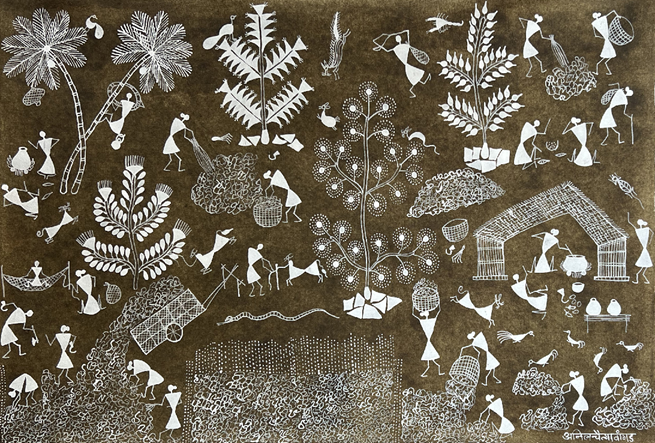
Despite its minimalistic approach, Warli art’s focus on storytelling and symbolism makes it a profound medium for expressing mythological beliefs.
Kalamkari
Kalamkari, practised in Andhra Pradesh and Telangana, employs intricate pen work using natural dyes to narrate epic tales. Derived from the words “kalam” (pen) and “kari” (work), this art form reflects an unmatched dedication to detail and storytelling.
Themes from the Mahabharata, Ramayana, and Puranas dominate Kalamkari art. Popular subjects include:
- The life of Lord Rama, from his exile to his victorious return to Ayodhya.
- Tales of Lord Krishna, particularly his divine guide and protector role.
The meticulous rendering of figures and motifs and the vibrant yet earthy colour palette ensure that every Kalamkari piece is a masterpiece of mythological narration.
Symbolism and Storytelling: Mythology as a Narrative Tool
In Indian folk paintings, mythology is more than just a source of subject matter. It is a powerful narrative tool, weaving complex stories into visually engaging formats. Key aspects include:
Symbolic Representation: Mythological characters are often portrayed with distinct attributes that make them easily identifiable. For example:
- Krishna, with his blue skin, flute, and cows, is instantly recognized as the divine shepherd.
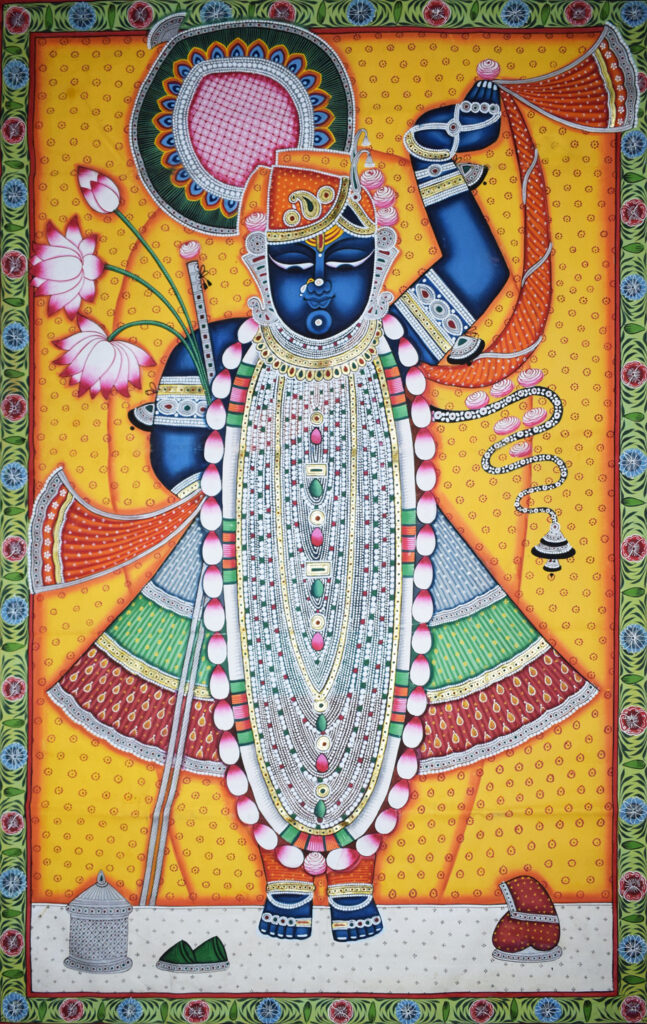
- Durga, depicted with multiple arms holding weapons, symbolizes strength and the triumph of good over evil.
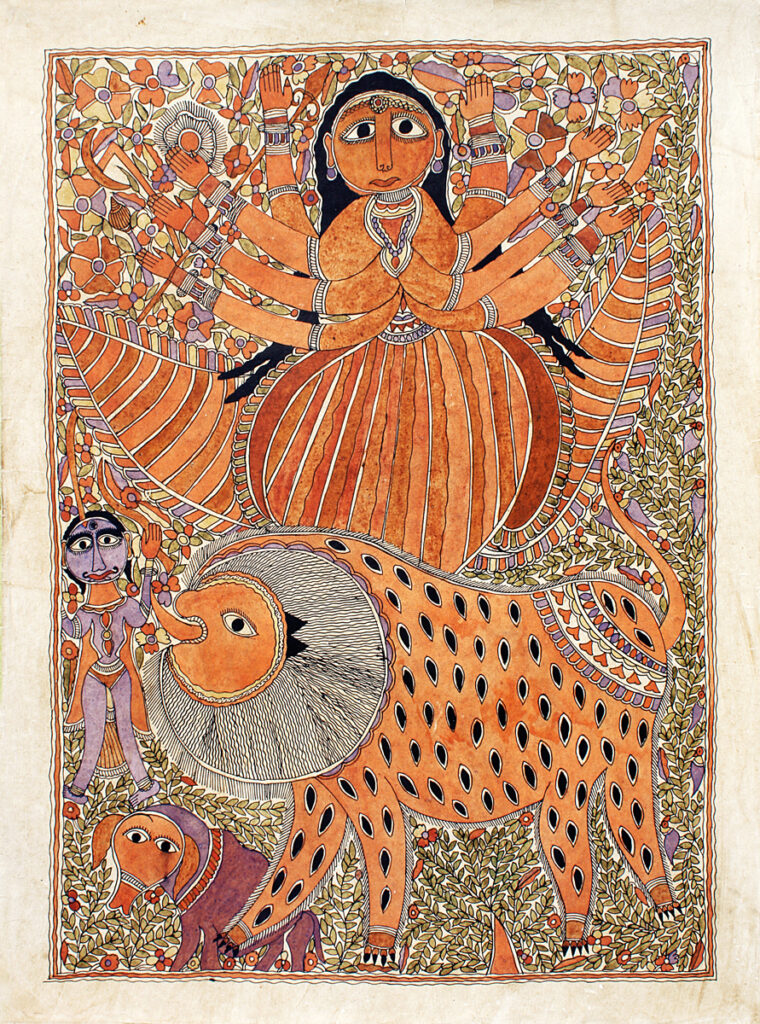
Moral Lessons: These paintings are didactic, using mythology to impart ethical values and spiritual teachings. For instance, the battle of Kurukshetra from the Mahabharata emphasizes the importance of dharma (duty) and karma (action), urging viewers to live righteously.
Community Identity: The mythological themes resonate with local customs and beliefs, fostering a shared cultural identity within communities. The Gond paintings, for example, feature stories of Bada Dev, the tribal god, blending mythology with indigenous practices to create a unique cultural tapestry.
The Role of Mythology in Rituals and Celebrations
Folk paintings often transcend the realm of decorative art, becoming integral to rituals and celebrations. These artworks are deeply woven into the cultural and spiritual fabric of the communities that create them. For example:
- Aipan art from Uttarakhand is created during festivals and religious ceremonies to invoke divine blessings. These intricate floor and wall designs are ephemeral, underscoring the transient yet meaningful connection between art and spirituality.
- Chittara art from Karnataka incorporates mythological themes to mark auspicious occasions like weddings. The symbolic patterns are believed to bring prosperity and ward off negative energies.
These ephemeral artworks demonstrate how mythology infuses daily life with spirituality and meaning. They remind us that art, in its purest form, celebrates life and the divine.
Mythology’s Influence on Modern Interpretations
While rooted in tradition, Indian folk paintings continue to evolve, finding relevance in contemporary contexts. Artists today are reimagining mythological stories to address modern themes such as environmental conservation, women’s empowerment, and social harmony. This fusion of old and new underscores the timeless nature of mythology and its adaptability to changing times.
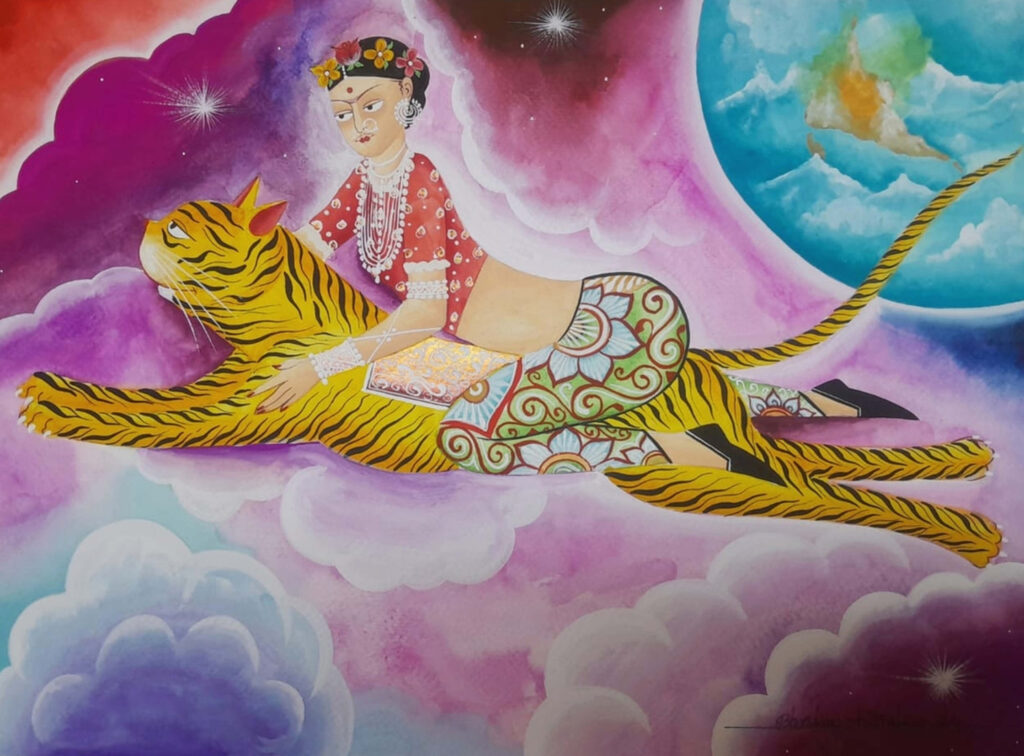
For instance:
- Some Madhubani artists use traditional motifs to highlight the importance of ecological balance, creating artworks celebrating biodiversity.
- Contemporary Kalamkari pieces often portray mythological characters in modern settings, drawing attention to issues like gender equality and social justice.
This blending of tradition with modernity ensures that Indian folk art remains vibrant and relevant globally.
Why Indian Folk Paintings Are Timeless
Indian folk paintings’ enduring appeal lies in their ability to convey universal truths through the lens of mythology. These artworks:
- Preserve heritage: They act as custodians of cultural history by depicting age-old tales. Each piece’s intricate details and narrative depth make them invaluable cultural artefacts.
- Engage audiences: The vibrant imagery and compelling stories resonate with art enthusiasts and collectors worldwide. Whether viewed in a traditional setting or a contemporary gallery, these paintings captivate with their charm and complexity.
- Foster connection: The themes of love, duty, and morality are as relevant today as they were centuries ago. They remind us of our shared humanity and the enduring power of storytelling.
Where to Explore and Collect Indian Folk Paintings
For art lovers and collectors, Indian folk paintings offer a gateway to India’s rich cultural tapestry. Whether you are a connoisseur or a first-time buyer, the online space provides a convenient platform to explore and purchase these masterpieces. Mojarto feature a curated selection of Indian folk art, ensuring authenticity and quality. From Madhubani to Kalamkari, each piece tells a unique story, making it a timeless addition to any collection.
Online platforms have made it easier than ever to connect with artists and understand the cultural significance of their work. By purchasing Indian folk paintings, you acquire a piece of art and contribute to preserving these age-old traditions.
Conclusion
The interplay of mythology and Indian folk paintings is a testament to the profound connection between art and storytelling. These paintings are not just visual treats but cultural treasures that keep the spirit of Indian mythology alive. As you explore the world of Indian folk art, you’re not just admiring an art form—you’re delving into a world of stories, beliefs, and traditions that have shaped India’s cultural landscape for millennia.
So why wait? Dive into this vibrant world and let the tales of the gods and goddesses inspire your artistic journey.